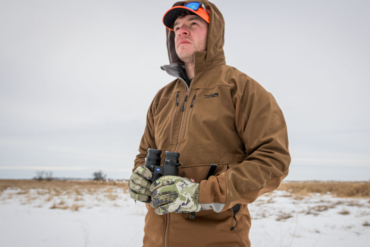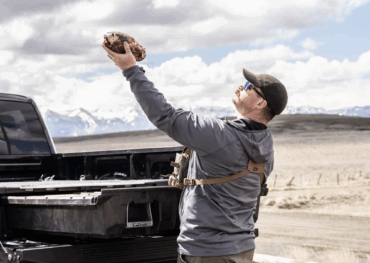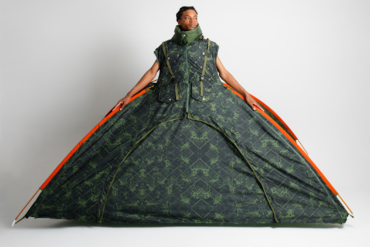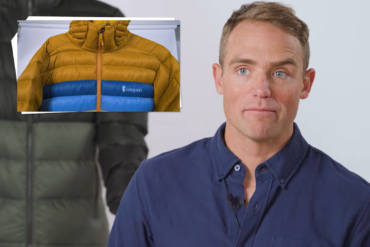The First Lite Typha waterfowl line is packed with premium features for bird hunters, including a new camo pattern.
The media blitz leading up to the Typha system launch had many waterfowlers excited for the upcoming season. First Lite gave us a chance to test the early season LZ Jacket and Omen Stormshelter Pant, and late season Refuge Parka and Refuge Bib featured in many of the clips. With each piece made to work within the Typha system, the layering and waterproof capabilities, along with the intuitive camo print, should enhance your hunting experience.
In order to get this gear tested, I tortured myself in this heatwave putting the system through the paces. The experience was helpful in gauging the fit, durability, and performance of the gear.
The Typha system is designed with a hunter’s needs in mind. Think wetland marshes, ag field setups, and enduring the frozen months of the late season. The new system might also persuade waterfowlers to take a look at adding the First Lite merino base layers to their setup.
In short: The Typha system should live up to its promise to keep most hunters dry, warm, and concealed. Though, I think it may take some time to convince some folks to adopt a system that doesn’t include darker patterns or waders. The real question is whether or not the system is worth the high-dollar price tag.
First Lite Typha Waterfowl System Review

Refuge Parka and Bib — A Solid Late-Season Combo
The big-ticket items in the line are the Refuge Parka and Refuge Bib. These two complementary late-season pieces were designed to keep you warm, and I believe they will. Although there is a noticeable amount of bulk with each item, the burly aspects should help keep you warm during the late season.
The bulk does not seem to limit movement either. As proclaimed, the Parka and Bib have plenty of room in the magnetic pockets for your shells and space to layer underneath as you prepare for those subzero days chasing late-season birds.

The Refuge Parka
Constructed of waterproof polyester with 300 g of synthetic insulation in the core section, the Refuge Parka is built to keep you warm and dry. It has a snap-off hood with three-point adjustment straps, allowing you to customize how/if you wear it.
It is loaded with pockets and attachment points and quite honestly, has more features than is truly necessary. The deep shell pockets mean you can reload with ease. The dual kill switch d-rings show an attention to detail when it comes to waterfowl hunting from a boat.
Overall, I was impressed with the Refuge Parka design. However, there are a few small items worth mentioning: The main zipper protective flap tends to get overlapped with the call concealment chest pocket leading to slight moments of frustration trying to sort through magnetic flaps.
While the option to close the chest pockets with a zipper is a nice touch, I still have not figured out why the pockets have an internal zipper. Why give trapped heat the opportunity to escape? Since the Parka is a longer jacket, the two-zipper is a nice feature to reduce restrictions when sitting. I would prefer the option to remove the wading belt altogether.
I do wish there was fleece or similar soft fabric on the inside of the neck collar rather than the bombshell material. Though, a neck gaiter can easily solve that issue.

The Refuge Bib
The waterproof Refuge Bibs come equipped with both knee and rear pads that seem to stay in place when moving around, a definite plus. Subtle features like the waterproof chest pocket for your phone or keys and the fur-lined chest pockets for warmth are well designed. The body-mapped insulation is well thought out, with 300 g in the seat, 200 g in the legs, 160 g in the back and body, and 60 g in the hand muff. This gives you bulk where you need it most.
The muff is lined with a hi-loft merino blend sherpa fleece, giving you both warmth and comfort.

The bibs have an integrated belt system that secures at the waist even when the shoulder straps are unhooked. While it is a nice feature, the dangling straps can be a bit of a nuisance, so I don’t see it being incredibly practical. However, I really liked that the shoulder strap clips are easy to detach.
The only real downside to the Refuge Bib is the full-length zipper function. To access the waist zipper, you must go through the steps of detaching a Velcro patch and unbuttoning a snap. Like most bibs, since the waist zipper is for venting purposes, you can’t completely detach the pants using this zipper, nor is there enough space to slide your boots through the bottom.

Instead, to detach the Bibs you must use the bottom zipper, which is blocked by another button. While I am sure each of these small attachment points was designed to keep the integrity of the Bibs when moving, if it’s freezing cold and I have bulky late-season gloves on, these extra steps could be burdensome.
Lightweight and Waterproof — LZ Jacket and Omen Stormshelter Pant
My favorite pairing of the First Lite Typha system is the LZ Jacket and Omen Stormshelter Pant. Both pieces are lightweight, waterproof, and windproof. In addition, adding the merino layers underneath allows you to use this combo throughout most of the season.

The LZ Jacket
The uninsulated, 4.5-layer, waterproof LZ jacket is a solid outer layer designed to keep you dry. It is lightweight and roomy enough to provide room for layering, meaning it can be a signature piece throughout the season. It features underarm casting strips for more easily giving your retriever commands, though I really think the dark patches add a nice shadowing effect when sitting in marshland habitats.
The lightweight nature of this jacket is great and the pit zips help release built-up heat. While I think the LZ jacket is an excellent waterproof shell with many features designed for a waterfowler, the three sets of chest pockets are a bit much.

The design of the collar and stowaway hood was less than impressive. If you tuck the hood in the collar, it creates a very tall heap when fully zipped and makes for awkwardly tall flaps on each side of your head when unzipped. I would suggest that most folks just leave the hood outside the collar.
Like the Refuge Parka, the LZ Jacket also has the wading belt buckle that creates an extra item to overcome. I think that if I were to wear this jacket underneath waders, the belt itself would suffice.

The Stormshelter Pant
Constructed of the same waterproof layers as the LZ Jacket, the Stormshelter Pant fits easily over waders for wetland setups but is also flexible enough to move with you through dry field spreads. They have a nice set of kneepads that come in handy when you contort yourself throughout a hunt.
The built-in splash guards around the boot opening are a nice touch to keep water out. They are roomy, waterproof, and lightweight.
The suspender system is easy to use, and if you aren’t a suspender person there are belt loops. Unfortunately, these pants have a similar issue to the Refuge Bib. The frustrating zipper system requires multiple steps to access the zippers. You can only use the bottom zipper to detach the sides, and the splash guard gaiter requires yet another button.
However, the buttons can also serve as a failsafe. If you don’t line up the bottom buttons before zipping the pants you can mismatch the zippers and attach the wrong pant legs together.
The Typha Origin and Kiln Hoodies
The merino wool layers are an excellent addition to this system, allowing you to layer up or down to fit the environment. Many big game hunters are accustomed to the benefits of merino wool. Now with the Typha pattern, you may see more waterfowl hunters adding merino wool base layers to their system.
The Origin Hoody and Kiln Hoody both performed as expected by moving moisture away from my body and limiting odor. The current heat wave provided plenty of opportunities to sweat through these tops. After hang drying them overnight, the limited lack of odor was stellar.
Main Drawbacks: Price, Bulk, Zippers, and No Waders
The initial drawback to the First Lite Typha system is its price. The Refuge Parka and Refuge Bib alone come in at $1,000. However, it’s tough to put a price on warmth when you have the opportunity to lure giant Canadas near the last bits of open water or available feeds in the late season. If you’re serious about chasing birds, it may just be worth it.
There is also the issue of heft. Layering up under the late season loadout can lead to some serious bulk.
While the research behind intuitive camo design is captivating, there will always be a demand for solids, which I assume First Lite may eventually expand into.
Finally, and most obvious, there will be a strong desire for a complimentary wader. I can only imagine that waders are in the works. For system junkies like myself, it just feels a bit awkward to wear another brand of waders with the system.
Typha Waterfowl System: Final Thoughts

Ultimately, there is no doubt that this system is built to suit most waterfowl pursuits. The waterproof, windproof, and insulation features should perform to keep you comfortable on those tough hunting days.
I think that Typha waterfowl system was designed with a true waterfowler mindset. It really is an ideal way to integrate waterfowlers into the First Lite brand.
While there are quite a few zips, loops, buttons, Velcro, and clips — none of these really take away from the performance of the gear. They each just present an opportunity to malfunction in rainy, snowy, or muddy conditions. That aside, it is a solid setup.
Although the First Lite Typha system is listed at a premium price, it should keep you warm and dry throughout the season. Based on the number of thoughtful features placed throughout the system, I am sure there will be more good stuff to come in the waterfowl category from the growing hunting brand … perhaps waders (hint-hint).







